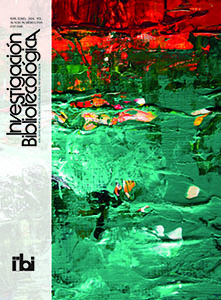Resumo
El objetivo de investigación se fundamenta en describir los sistemas de información pervasivos contemporáneos con base en los presupuestos teóricos seleccionados. A partir de un método inductivo guiado por diferentes posturas hacia las características de los sistemas de información pervasivos, se sintetizan ciertos elementos a manera de armonización conceptual basados en la computación pervasiva. Los resultados obtenidos a nivel conceptual denotan que un sistema de información pervasivo contemporáneo tiende a expandirse en el tiempo y espacio del área de trabajo, puesto que las actividades laborales y los servicios de información han transgredido los momentos y sitios personales ajenos a las tareas específicas del lugar de trabajo.
Referências
Birnbaum, Joel. 1997. “Pervasive Information Systems”. Communications of the ACM 40 (2): 40-41. https://dl.acm.org/doi/pdf/10.1145/253671.253695
Bott, Ed. 2015. “Microsoft’s Obsession with Piracy Threatens to Create a Windows 10 Licensing Mess”. Zdnet, 21 de marzo. https://www.zdnet.com/article/will-microsoft-piracy-obsession-create-awindows-10-licensing-mess/
Brooks, Chuck. 2020. “The Merging of Human and Machine. Two Frontiers of Emerging Technologies”. Forbes, 27 de abril. https://www.forbes.com/sites/chuckbrooks/2020/08/27/the-merging-ofhuman-and-machine-two-frontiers-of-emerging-technologies/?sh=5ee086451fad
Bull, Peter, Ryan Limb y James Payne. 2006. “Pervasive Home Environments”. En Intelligent Spaces: Computer Communications and Networks, editado por Alan Steventon y Steve Wright, 81-91. Londres: Springer.
Chandra, Deepak. 2021. “Pervasive Computing”. National Informatics Centre, 14 de octubre. https://www.nic.in/blogs/pervasive-computing/
Cheney, Catherine. 2020. “How WhatsApp Became the Tool of Choice for WHO’s COVID- 19 Messaging”. Devex, 17 de agosto. https://www.devex.com/news/how-whatsapp-became-the-tool-of-choice-for-whos-covid-19-messaging-97910
Dingli, Alexiei, y Daniel Tanti. 2015. “Pervasive Social Network”. UBICOMM 2015: The Ninth International Conference on Mobile Ubiquitous Computing, Systems, Services and Technologies: 31-37. https://personales.upv.es/thinkmind/dl/conferences/ubicomm/ubicomm_2015/ubicomm_2015_2_20_10025.pdf
FIT (Florida Institute of Technology). 2023. “5 Types of Information Systems”. Florida Tech. Consultado el 26 de noviembre de 2023. https://www.floridatechonline.com/blog/information-technology/5-types-of-information-systems/
Gabriel, Peter, Marc Bovenschulte y Ernst Hartmann. 2006. Pervasive Computing: Trends and Impacts. Bonn: Federal Office for Information Security.
Giner, Pau, Carlos Cetina, Joan Fons y Vicente Pelechano. 2009. “A Framework for the Reconfiguration of Ubicomp Systems”. En Third Symposium of Ubiquitous Computing and Ambient Intelligence 2008, editado por Juan Corchado, Dante Tapia y José Bravo, 1- 10. Berlin: Springer. https://doi.org/10.1007/978-3-540-85867-6_1
Hayes, Emma. 2023. “10 Different Types of Information Systems: Explained in Plain English”. History-Computer, 6 de agosto. https://history-computer.com/different-types-of-information-systems-explained-in-plain-english/
Hilty, Lorenz, Claudia Som y Andreas Köhler. 2004. “Assessing the Human, Social and Environmental Risks of Pervasive Computing”. Human and Ecological Risk Assessment: An International Journal 10 (5): 853-74. https://doi.org/10.1080/10807030490513874
Hong, Sun-Ha. 2021. “Technofutures in Stasis: Smart Machines, Ubiquitous Computing, and the Future That Keeps Coming Back”. International Journal of Communication 15: 1940-60. https://ijoc.org/index.php/ijoc/article/view/15697
Jurado Pérez, Luis Alberto. 2014. “Arquitecturas de computación pervasiva basadas en servicios REST”. Tesis de maestría, Universidad Politécnica de Madrid. https://www.dit.upm.es/~posgrado/doc/TFM/TFMs2013-2014/TFM_Luis_Alberto_Jurado_2014.pdf
Khalfi, Mohammed Fethi, y Sidi Mohamed Benslimane. 2013. “Toward A Generic Infrastructure for Ubiquitous Computing”. International Journal of Advanced Pervasive and Ubiquitous Computing 5 (1): 66-85. http://doi.org/10.4018/japuc.2013010107
Klovig, Sebastian Klovig. 2022. “Microsoft 365 Banned in German Schools over Privacy Concerns”. Computer Weekly, 30 de noviembre. https://www.computerweekly.com/news/252527842/Microsoft-365-banned-in-German-schools-over-privacy-concerns
Kostakos, Vassilis, Eamonn O’Neill y Alan Penn. 2006. “Designing Urban Pervasive Systems”. IEEE Computer Society 39 (9): 52-59. http://doi.org/10.1109/MC.2006.303
Kourouthanassis, Panos, George Giaglis y Adam Vrechopoulos. 2007. “Enhancing User Experience through Pervasive Information Systems: The Case of Pervasive Retailing”. International Journal of Information Management 27: 319-35. https://doi.org/10.1016/j.ijinfomgt.2007.04.005
Lyytinen, Kalle, y Youngjin Yoo. 2002. “Issues and Challenges in Ubiquitous Computing”. Communications of the ACM 45 (12): 63-65. https://dl.acm.org/doi/10.1145/585597.585616
Miao, Zhenjiang, y Baozong Yuan. 2005. “Discussion on Pervasive Computing Paradigm”. TENCON 2005 - 2005 IEEE Region 10 Conference: 1-6. https://ieeexplore.ieee.org/document/4084985
Molla, Rani. 2020. “The Pandemic was Great for Zoom. What Happens When There’s a Vaccine?”. Vox, 4 de diciembre. https://www.vox.com/recode/21726260/zoom-microsoft-teams-video-conferencing-post-pandemic-coronavirus
Mukherjee, Sritoma. 2022. “The 6 Types of Information Systems and Their Applications”. Emeritus, 24 de julio. https://emeritus.org/in/learn/the-6-types-of-information-systems-and-their-applications/
Muñoz, Javier, Idoia Ruiz, Vicente Pelechano y Carlos Cetina. 2005. “Un framework para la simulación de sistemas pervasivos”. Actas del Simposio de Computación Ubicua e Inteligencia Ambiental, UCAmI2005: 181-89. https://pros2.webs.upv.es/media/pervml/jmunoz_ucami2005.pdf
Phillips, Gavin. 2023. “Why You Don’t Need Adobe Reader (And What to Use Instead)”. Make Use of, 28 de mayo. https://www.makeuseof.com/tag/this-is-why-you-dont-need-adobe-reader/
Quinde, Catalina. 2012. “¿Qué es la computación ubicua o pervasiva?”. Computación ubicua o pervasiva (blog), 25 de abril. http://computacionpervasiva.blogspot.com/2012/04/que-es-la-computacion-ubicua-o_25.html
Rangel Romero, Miguel Ángel, Adriana Lorena Íñiguez Carrillo y Abraham Jair López Villalvazo. 2021. “Valoración de la herramienta Google Drive durante el trabajo colaborativo universitario”. Revista Iberoamericana para la Investigación y el Desarrollo Educativo 11 (22). https://doi.org/10.23913/ride.v11i22.944
Ratcliffe, Martyn, y Bin Hu. 2007. “State Based Analysis of Pervasive Systems”. Second International Conference on Pervasive Computing and Applications: 572-76. https://ieeexplore.ieee.org/document/4365509
Renteria, Leonardo, Ángel Mayacela, Mayra Rojas, Margarita Mayacela y Ángela Mayacela. 2021. “Facebook como herramienta educativa emergente en el proceso de enseñanza-aprendizaje de nivel inicial en tiempos de pandemia”. Novasinergia 4 (1): 42-52. https://doi.org/10.37135/ns.01.07.02
Segura, Alexander. 2016. “The Internet of Things: Business Applications, Technology Acceptance, and Future Prospects Dissertation”. Tesis de doctorado, Julius Maximilian Universidad de Wurzburgo. https://d-nb.info/1111888264/34
Sánchez, Carlos. 2015. “La computación ubicua: omnipresencia en los sistemas de información”. Revista Tecnura 19: 121-28. http://ref.scielo.org/3j5p89
Shea, Sharon. 2019. “Pervasive Computing (Ubiquitous Computing)”. Tech Target, https://www.techtarget.com/iotagenda/definition/pervasive-computing-ubiquitous-computing
Silvis-Cividjian, Natalia. 2017. Pervasive Computing. Suiza: Springer.
Simplilearn. 2023. “The 6 Most Popular Types of Information Systems and Their Applications”. 5 de octubre. https://www.simplilearn.com/types-of-information-systems-and-applications-article
Taconet, Chantal, Thais Batista, Pedro Borges, Georgios Bouloukakis, Everton Cavalcante, Sophie Chabridon, Denis Conan, Thierry Desprats y Denisse Muñante. 2023. “Middleware Supporting PIS: Requirements, Solutions, and Challenges”. En The Evolution of Pervasive Information Systems, editado por Manuele Kirsch, Carine Souveyet, Philippe Roose y Luiz Steffenel, 65-97. Cham: Springer.
The Financial Times. 2020. “Prospering in the Pandemic: The Top 100 Companies”. 18 de junio. https://www.ft.com/content/844ed28c-8074-4856-bde0-20f3bf4cd8f0
Thompson, Simon, y Ben Azvine. 2004. “No Pervasive Computing without Intelligent Systems”. BT Technolog y Journal 22: 39-49. https://doi.org/10.1023/B:BTTJ.0000047118.95476.14
Weiser, Mark. 1991. “The Computer for the 21st Century”. Scientific American 265: 78-89. https://ics.uci.edu/~djp3/classes/2012_09_INF241/papers/Weiser-Computer-21Century-SciAm.pdf
Wilson, Mark. 2021. “Adobe Gives Students Free Home Creative Cloud Access – Here’s How to Get it”. TechRadar, 1 de diciembre. https://www.techradar.com/news/adobe-gives-students-free-home-creative-cloudaccess-heres-how-to-get-it
Ye, Juan, Simon Dobson y Paddy Nixon. 2008. “An Overview of Pervasive Computing Systems”. En Ambient Intelligence with Microsystems: Augmented Materials and Smart Objects, editado por Kieran Delaney, 3-17. Nueva York: Springer.
Zhou, Jiehan, Junzhao Sun, Kumaripaba Athukorala y Dinesh Wijekoon. 2010. “Pervasive Social Computing: Augmenting Five Facets of Human Intelligence”. Seventh International Conference on Ubiquitous Intelligence & Computing and Seventh International Conference on Autonomic & Trusted Computing: 1-6. https://ieeexplore.ieee.org/document/5667101
Os autores
- Devem enviar, para a revista Investigación Bibliotecológica: archivonomía, bibliotecología e información, a Carta de autorização para a publicação de artigos.
- cedem o total direito de propriedade intelectual do material submetido à revista; sendo permitido, entretanto, compartir o conhecimento contido na obra nos seguintes âmbitos:
- Apoio à docência;
- Conferências;
- Auto arquivamento em repositórios académicos.
- Difusão em redes acadêmicas.
- Difusão em blogs, site e página pessoal do autor.
Essa difusão será possível sempre e quando se respeitem as condições de uso dos conteúdos da revista, de acordo à licença Creative Commons:Atribución – No comercial – Sin Derivar 4.0 empregada; e que nos três últimos casos a descarga do texto completo se realize através de links do sistema DOI.
Política de auto arquivamento
Em caso de publicação da obra como modo de auto arquivamento, os autores devem cumprir com as seguintes condições:
a) Reconhecer o direito de autor da revista Investigação Biblioteconômica: arquivologia, biblioteconomia e informação.
b) Estabelecer um link com a versão original submetida no site da revista (DOI do artigo, por exemplo).
c) Difundir a versão definitiva publicada pela revista.
Licença dos conteúdos
A revista Investigación Bibliotecológica: archivonomía, bibliotecología e información permite o acesso e uso de seu conteúdo segundo a licença Creative Commons: Atribuição – Não comercial – Sem Derivar 4.0.

O que implica que os conteúdos apenas podem ser lidos e compartilhados se se reconhece e menciona a autoria da obra. Não se permite o uso da obra alterada ou com fins lucrativos.
Demarcação de responsabilidades
A revista não se faz responsável em caso de que o autor tenha incorrido em fraude ou plágio científico, tampouco dos elegidos pelos autores. Igualmente, não se faz responsável pelos serviços oferecidos por terceiros, a partir dos links disponíveis nos artigos dos autores.
Corroborando, a revista disponibiliza as responsabilidades que o autor deve cumprir no processo de publicação na revista Investigación Bibliotecológica: archivonomía, bibliotecología e información, no seguinte link: Responsabilidades do autor.
No caso de migração de conteúdo do site oficial da revista, implicando alteração de IP ou domínio, o diretor ou editor da revista deverá informá-lo aos autores.








